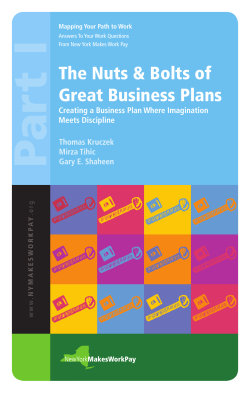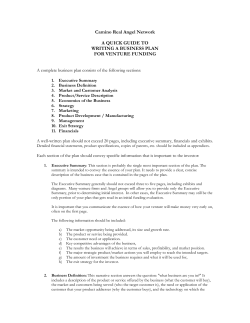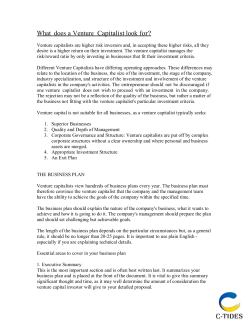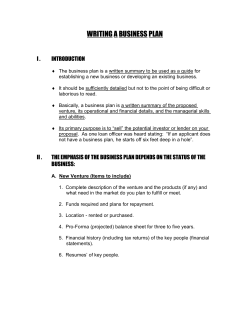
How to write a great business plan
How to write a great business plan Author(s):William A. Sahlman. Source:Harvard Business Review 75.n4 (July-August 1997): pp98(11). (6768 words) Document Type:Magazine/Journal Bookmark:Bookmark this Document Library Links: Abstract: Business plans are undoubtedly one of the core aspects that determine the success of an organization. According to a Stanford University professor, an ideal business plan is that which properly assesses the people involved in the venture operation, various risks associated with the business and the schematic profile of the business itself. More importantly, the plan must consider the impact of interest rate, demographic factors, inflation and regulatory measures to the business. After the plan has been successfully laid out, managers must be able to ensure the simplicity and fairness of the deal. Full text: Few areas of business attract as much attention as new ventures, and few aspects of newventure creation attract as much attention as the business plan. Countless books and articles in the popular press dissect the topic. A growing number of annual business-plan contests are springing up across the United States and, increasingly, in other countries. Both graduate and undergraduate schools devote entire courses to the subject. Indeed, judging by all the hoopla surrounding business plans, you would think that the only things standing between a would-be entrepreneur and spectacular success are glossy five-color charts, a bundle of meticulous-looking spreadsheets, and a decade of month-by-month financial projections. Nothing could be further from the truth. In my experience with hundreds of entrepreneurial start-ups, business plans rank no higher than 2 -- on a scale from 1 to 10 -- as a predictor of a new venture's success. And sometimes, in fact, the more elaborately crafted the document, the more likely the venture is to, well, flop, for lack of a more euphemistic word. What's wrong with most business plans? The answer is relatively straightforward. Most waste too much ink on numbers and devote too little to the information that really matters to intelligent investors. As every seasoned investor knows, financial projections for a new company -- especially detailed, month-by-month projections that stretch out for more than a year -- are an act of imagination. An entrepreneurial venture faces far too many unknowns to predict revenues, let alone profits. Moreover, few if any entrepreneurs correctly anticipate how much capital and time will be required to accomplish their objectives. Typically, they are wildly optimistic, padding their projections. Investors know about the padding effect and therefore discount the figures in business plans. These maneuvers create a vicious circle of inaccuracy that benefits no one. Don't misunderstand me: business plans should include some numbers. But those numbers should appear mainly in the form of a business model that shows the entrepreneurial team has thought through the key drivers of the venture's success or failure. In manufacturing, such a driver might be the yield on a production process; in magazine publishing, the anticipated renewal rate; or in software, the impact of using various distribution channels. The model should also address the break-even issue: At what level of sales does the business begin to make a profit? And even more important, When does cash flow turn positive? Without a doubt, these questions deserve a few pages in any business plan. Near the back. What goes at the front? What information does a good business plan contain? If you want to speak the language of investors -- and also make sure you have asked yourself the right questions before setting out on the most daunting journey of a businessperson's career -- I recommend basing your business plan on the framework that follows. It does not provide the kind of "winning" formula touted by some current how-to books and software programs for entrepreneurs. Nor is it a guide to brain surgery. Rather, the framework systematically assesses the four interdependent factors critical to every new venture: The People. The men and women starting and running the venture, as well as the outside parties providing key services or important resources for it, such as its lawyers, accountants, and suppliers. The Opportunity. A profile of the business itself -- what it will sell and to whom, whether the business can grow and how fast, what its economics are, who and what stand in the way of success. The Context. The big picture -- the regulatory environment, interest rates, demographic trends, inflation, and the like -- basically, factors that inevitably change but cannot be controlled by the entrepreneur. Risk and Reward. An assessment of everything that can go wrong and right, and a discussion of how the entrepreneurial team can respond. The assumption behind the framework is that great businesses have attributes that are easy to identify but hard to assemble. They have an experienced, energetic managerial team from the top to the bottom. The team's members have skills and experiences directly relevant to the opportunity they are pursuing. Ideally, they will have worked successfully together in the past. The opportunity has an attractive, sustainable business model; it is possible to create a competitive edge and defend it. Many options exist for expanding the scale and scope of the business, and these options are unique to the enterprise and its team. Value can be extracted from the business in a number of ways either through a positive harvest event -- a sale -- or by scaling down or liquidating. The context is favorable with respect to both the regulatory and the macroeconomic environments. Risk is understood, and the team has considered ways to mitigate the impact of difficult events. In short, great businesses have the four parts of the framework completely covered. If only reality were so neat. The People When I receive a business plan, I always read the resume section first. Not because the people part of the new venture is the most important, but because without the right team, none of the other parts really matters. I read the resumes of the venture's team with a list of questions in mind. (See the insert "Who Are These People, Anyway?") All these questions get at the same three issues about the venture's team members: What do they know? Whom do they know? and How well are they known? What and whom they know are matters of insight and experience. How familiar are the team members with industry players and dynamics? Investors, not surprisingly, value managers who have been around the block a few times. A business plan should candidly describe each team member's knowledge of the new venture's type of product or service; its production processes; and the market itself, from competitors to customers. It also helps to indicate whether the team members have worked together before. Not played -- as in roomed together in college -- but worked. Investors also look favorably on a team that is known because the real world often prefers not to deal with start-ups. They're too unpredictable. That changes, however, when the new company is run by people well known to suppliers, customers, and employees. Their enterprise may be brand new, but they aren't. The surprise element of working with a startup is somewhat ameliorated. Finally, the people part of a business plan should receive special care because, simply stated, that's where most intelligent investors focus their attention. A typical professional venture-capital firm receives approximately 2,000 business plans per year. These plans are filled with tantalizing ideas for new products and services that will change the world and reap billions in the process -- or so they say. But the fact is, most venture capitalists believe that ideas are a dime a dozen: only execution skills count. As Arthur Rock, a venture capital legend associated with the formation of such companies as Apple, Intel, and Teledyne, states, "I invest in people, not ideas." Rock also has said, "If you can find good people, if they're wrong about the product, they'll make a switch, so what good is it to understand the product that they're talking about in the first place?" Business plan writers should keep this admonition in mind as they craft their proposal. Talk about the people -- exhaustively. And if there is nothing solid about their experience and abilities to herald, then the entrepreneurial team should think again about launching the venture. The Opportunity When it comes to the opportunity itself, a good business plan begins by focusing on two questions: Is the total market for the venture's product or service large, rapidly growing, or both? Is the industry now, or can it become, structurally attractive? Entrepreneurs and investors look for large or rapidly growing markets mainly because it is often easier to obtain a share of a growing market than to fight with entrenched competitors for a share of a mature or stagnant market. Smart investors, in fact, try hard to identify high-growthpotential markets early in their evolution: that's where the big payoffs are. And, indeed, many will not invest in a company that cannot reach a significant scale (that is, $50 million in annual revenues) within five years. As for attractiveness, investors are obviously looking for markets that actually allow businesses to make some money. But that's not the no-brainer it seems. In the late 1970s, the computer disk-drive business looked very attractive. The technology was new and exciting. Dozens of companies jumped into the fray, aided by an army of professional investors. Twenty years later, however, the thrill is gone for managers and investors alike. Disk drive companies must design products to meet the perceived needs of original equipment manufacturers (OEMs) and end users. Selling a product to OEMs is complicated. The customers are large relative to most of their suppliers. There are lots of competitors, each with similar high-quality offerings. Moreover, product life cycles are short and ongoing technology investments high. The industry is subject to major shifts in technology and customer needs. Intense rivalry leads to lower prices and, hence, lower margins. In short, the disk drive industry is simply not set up to make people a lot of money; it's a structural disaster area. The information services industry, by contrast, is paradise. Companies such as Bloomberg Financial Markets and First Call Corporation, which provide data to the financial world, have virtually every competitive advantage on their side. First, they can assemble or create proprietary content -- content that, by the way, is like life's blood to thousands of money managers and stock analysts around the world. And although it is often expensive to develop the service and to acquire initial customers, once up and running, these companies can deliver content to customers very cheaply. Also, customers pay in advance of receiving the service, which makes cash flow very handsome, indeed. In short, the structure of the information services industry is beyond attractive: it's gorgeous. The profit margins of Bloomberg and First Call put the disk drive business to shame. Thus, the first step for entrepreneurs is to make sure they are entering an industry that is large and/or growing, and one that's structurally attractive. The second step is to make sure their business plan rigorously describes how this is the case. And if it isn't the case, their business plan needs to specify how the venture will still manage to make enough of a profit that investors (or potential employees or suppliers, for that matter) will want to participate. Once it examines the new venture's industry, a business plan must describe in detail how the company will build and launch its product or service into the marketplace. Again, a series of questions should guide the discussion. (See the insert "The Opportunity of a Lifetime--or Is It?") Often the answers to these questions reveal a fatal flaw in the business. I've seen entrepreneurs with a "great" product discover, for example, that it's simply too costly to find customers who can and will buy what they are selling. Economically viable access to customers is the key to business, yet many entrepreneurs take the Field of Dreams approach to this notion: build it, and they will come. That strategy works in the movies but is not very sensible in the real world. It is not always easy to answer questions about the likely consumer response to new products or services. The market is as fickle as it is unpredictable. (Who would have guessed that plug-in room deodorizers would sell?) One entrepreneur I know proposed to introduce an electronic newsclipping service. He made his pitch to a prospective venturecapital investor who rejected the plan, stating, "I just don't think the dogs will eat the dog food." Later, when the entrepreneur's company went public, he sent the venture capitalist an anonymous package containing an empty can of dog food and a copy of his prospectus. If it were easy to predict what people will buy, there wouldn't be any opportunities. Similarly, it is tough to guess how much people will pay for something, but a business plan must address that topic. Sometimes,"the dogs will eat the dog food, but only at a price less than cost. Investors always look for opportunities for value pricing -- that is, markets in which the costs to produce the product are low, but consumers will still pay a lot for it. No one is dying to invest in a company when margins are skinny. Still, there is money to be made in inexpensive pr6ducts and services -even in commodities. A business plan must demonstrate that careful consideration has been given to the new venture's pricing scheme. The list of questions about the new venture's opportunity focuses on the direct revenues and the costs of producing and marketing a product. That's fine, as far as it goes. A sensible proposal, however, also involves assessing the business model from a perspective that takes into account the investment required -- that is, the balance sheet side of the equation. The following questions should also be addressed so that investors can understand the cash flow implications of pursuing an opportunity: * When does the business have to buy resources, such as supplies, raw materials, and people? * When does the business have to pay for them? * How long does it take to acquire a customer? * How long before the customer sends the business a check? * How much capital equipment is required to support a dollar of sales? Investors, of course, are looking for businesses in which management can buy low, sell high, collect early, and pay late. The business plan needs to spell out how close to that ideal the new venture is expected to come. Even if the answer is "not very" -- and it usually is -at least the truth is out there to discuss. The opportunity section of a business plan must also bring a few other issues to the surface. First, it must demonstrate and analyze how an opportunity can grow -- in other words, how the new venture can expand its range of products or services, customer base, or geographic scope. Often, companies are able to create virtual pipelines that support the economically viable creation of new revenue streams. In the publishing business, for example, Inc. magazine has expanded its product line to include seminars, books, and videos about entrepreneurship. Similarly, building on the success of its personal-finance software program Quicken, Intuit now sells software for electronic banking, small-business accounting, and tax preparation, as well as personal-printing supplies and on-line information services -- to name just a few of its highly profitable ancillary spin-offs. Now, lots of business plans runneth over on the subject of the new venture's potential for growth and expansion. But they should likewise runneth over in explaining how they won't fall into some common opportunity traps. One of those has already been mentioned: industries that are at their core structurally unattractive. But there are others. The world of invention, for example, is fraught with danger. Over the past 15 years, I have seen scores of individuals who have devised a better mousetrap -- newfangled creations from inflatable pillows for use on airplanes to automated car-parking systems. Few of these idea-driven companies have really taken off, however. I'm not entirely sure why. Sometimes, the inventor refuses to spend the money required by or share the rewards sufficiently with the business side of the company. Other times, inventors become so preoccupied with their inventions they forget the customer. Whatever the reason, better-mousetrap businesses have an uncanny way of malfunctioning. Another opportunity trap that business plans -- and entrepreneurs in general -- need to pay attention to is the tricky business of arbitrage. Basically, arbitrage ventures are created to take advantage of some pricing disparity in the marketplace. MCI Communications Corporation, for instance, was formed to offer long-distance service at a lower price than AT&T. Some of the industry consolidations going on today reflect a different kind of arbitrage -- the ability to buy small businesses at a wholesale price, roll them up together into a larger package, and take them public at a retail price, all without necessarily adding value in the process. Taking advantage of arbitrage opportunities is a viable and potentially profitable way to enter a business. In the final analysis, however, all arbitrage opportunities evaporate. It is not a question of whether, only when. The trick in these businesses is to use the arbitrage profits to build a more enduring business model, and business plans must explain how and when that will occur. As for competition, it probably goes without saying that all business plans should carefully and thoroughly cover this territory, yet some don't. That is a glaring omission. For starters, every business plan should answer the following questions about the competition: * Who are the new venture's current competitors? * What resources do they control? What are their strengths and weaknesses? * How will they respond to the new venture's decision to enter the business? * How can the new venture respond to its competitors' response? * Who else might be able to observe and exploit the same opportunity? * Are there ways to co-opt potential or actual competitors by forming alliances? Business is like chess: to be successful, you must anticipate several moves in advance. A business plan that describes an insuperable lead or a proprietary market position is by definition written by naive people. That goes not just for the competition section of the business plan but for the entire discussion of the opportunity. All opportunities have promise; all have vulnerabilities. A good business plan doesn't whitewash the latter. Rather, it proves that the entrepreneurial team knows the good, the bad, and the ugly that the venture faces ahead. The Context Opportunities exist in a context. At one level is the macroeconomic environment, including the level of economic activity, inflation, exchange rates, and interest rates. At another level are the wide range of government rules and regulations that affect the opportunity and how resources are marshaled to exploit it. Examples extend from tax Policy to the rules about raising capital for a private or public company. And at yet another level are factors like technology that define the limits of what a business or its competitors can accomplish. Context often has a tremendous impact on every aspect of the entrepreneurial process, from identification of opportunity to harvest. In some cases, changes in some contextual factor create opportunity. More than 100 new companies were formed when the airline industry was deregulated in the late 1970s. The context for financing was also favorable, enabling new entrants like People Express to go to the public market for capital even before starting operations. Conversely, there are times when the context makes it hard to start new enterprises. The recession of the early 1990s combined with a difficult financing environment for new companies: venture capital disbursements were low, as was the amount of capital raised in the public markets. (Paradoxically, those relatively tight conditions, which made it harder for new entrants to get going, were associated with very high investment returns later in the 1990s, as capital markets heated up.) Sometimes, a shift in context turns an unattractive business into an attractive one, and vice versa. Consider the case of a packaging company some years ago that was performing so poorly it was about to be put on the block. Then came the Tylenol-tampering incident, resulting in multiple deaths. The packaging company happened to have an efficient mechanism for installing tamper-proof seals, and in a matter of weeks its financial performance could have been called spectacular. Conversely, U.S. tax reforms enacted in 1986 created havoc for companies in the real estate business, eliminating almost every positive incentive to invest. Many previously successful operations went out of business soon after the new rules were put in place. Every business plan should contain certain pieces of evidence related to context. First, the entrepreneurs should show a heightened awareness of the new venture's context and how it helps or hinders their specific proposal. Second, and more important, they should demonstrate that they know the venture's context will inevitably change and describe how those changes might affect the business. Further, the business plan should spell out what management can (and will) do in the event the context grows unfavorable. Finally, the business plan should explain the ways (if any) in which management can affect context in a positive way. For example, management might be able to have an impact on regulations or on industry standards through lobbying efforts. Risk and Reward The concept that context is fluid leads directly to the fourth leg of the framework I propose: a discussion of risk and how to manage it. I've come to think of a good business plan as a snapshot of an event in the future. That's quite a feat to begin with -- taking a picture of the unknown. But the best business plans go beyond that; they are like movies of the future. They show the people, the opportunity, and the context from multiple angles. They offer a plausible, coherent story of what lies ahead. They unfold possibilities of action and reaction. Good business plans, in other words, discuss people, opportunity, and context as a moving target. All three factors (and the relationship among them) are likely to change over time as a company evolves from start-up to ongoing enterprise. Therefore, any business plan worth the time it takes to write or read needs to focus attention on the dynamic aspects of the entrepreneurial process. Of course, the future is hard to predict. Still, it is possible to give potential investors a sense of the kind and class of risk and reward they are assuming with a new venture. All it takes is a pencil and two simple drawings. (See the insert "Visualizing Risk and Reward.") But even with these drawings, risk is, well, risky. In reality, there are no immutable distributions of outcomes. It is ultimately the responsibility of management to change the distribution, to increase the likelihood and consequences of success, and to decrease the likelihood and implications of problems. One of the great myths about entrepreneurs is that they are risk seekers. All sane people want to avoid risk. As Harvard Business School professor (and venture capitalist) Howard Stevenson says, true entrepreneurs want to capture all the reward and give all the risk to others. The best business is a post office box to which people send cashier's checks. Yet risk is unavoidable. So what does that mean for a business plan? It means that the plan must unflinchingly confront the risks ahead -- in terms of people, opportunity, and context. What happens if one of the new venture's leaders leaves? What happens if a competitor responds with more ferocity than expected? What happens if there is a revolution in Namibia, the source of a key raw material? What will management actually do? Those are hard questions for an entrepreneur to pose, especially when seeking capital. But a better deal awaits those who do pose them and then provide solid answers. A new venture, for example, might be highly leveraged and therefore very sensitive to interest rates. Its business plan would benefit enormously by stating that management intends to hedge its exposure through the financial-futures market by purchasing a contract that does well when interest rates go up. That is the equivalent of offering investors insurance. (It also makes sense for the business itself.) Finally, one important area in the realm of risk/reward management relates to harvesting. Venture capitalists often ask if a company is "IPOable," by which they mean, Can the company be taken public at some point in the future? Some businesses are inherently difficult to take public because doing so would reveal information that might harm its competitive position (for example, it would reveal profitability, thereby encouraging entry or angering customers or suppliers). Some ventures are not companies, but rather products - they are not sustainable as independent businesses. Therefore, the business plan should talk candidly about the end of the process. How will the investor eventually get money out of the business, assuming it is successful, even if only marginally so? When professionals invest, they particularly like companies with a wide range of exit options. They like companies that work hard to preserve and enhance those options along the way, companies that don't, for example, unthinkingly form alliances with big corporations that could someday actually buy them. Investors feel a lot better about risk if the venture's endgame is discussed up front. There is an old saying, "If you don't know where you are going, any road will get you there." In crafting sensible entrepreneurial strategies, just the opposite is true: you had better know where you might end up and have a map for getting there. A business plan should be the place where that map is drawn, for, as every traveler knows, a journey is a lot less risky when you have directions. Source Citation:Sahlman, William A. "How to write a great business plan." Harvard Business Review 75.n4 (July-August 1997): 98(11). Business & Management Journals. Gale. Ashridge Business School - Custom. 20 Apr. 2009 <http://find.galegroup.com/itx/start.do?prodId=SPJ.SP00>.
© Copyright 2025










